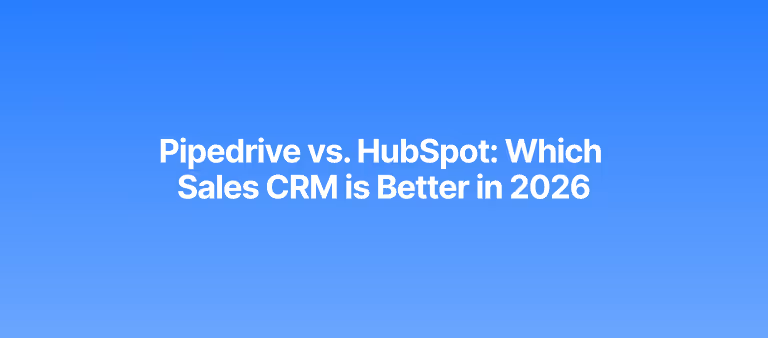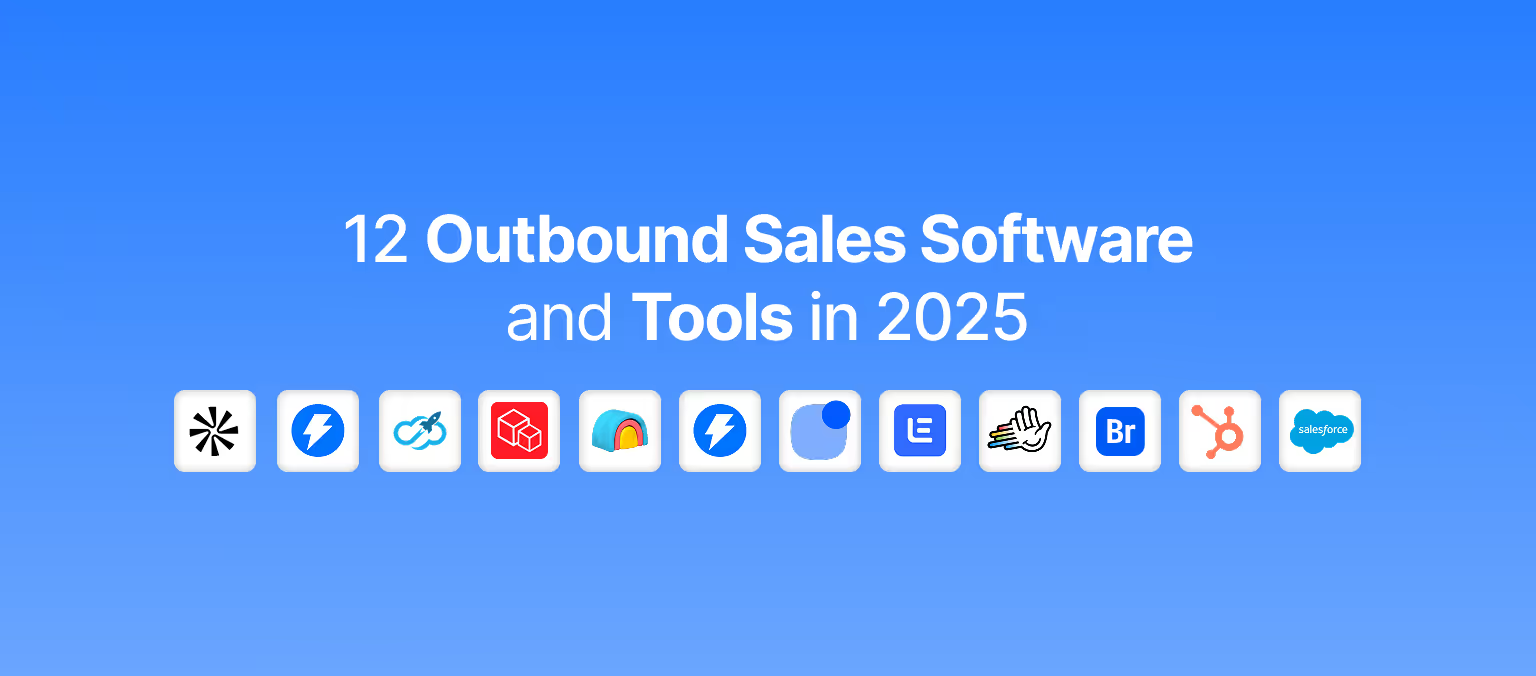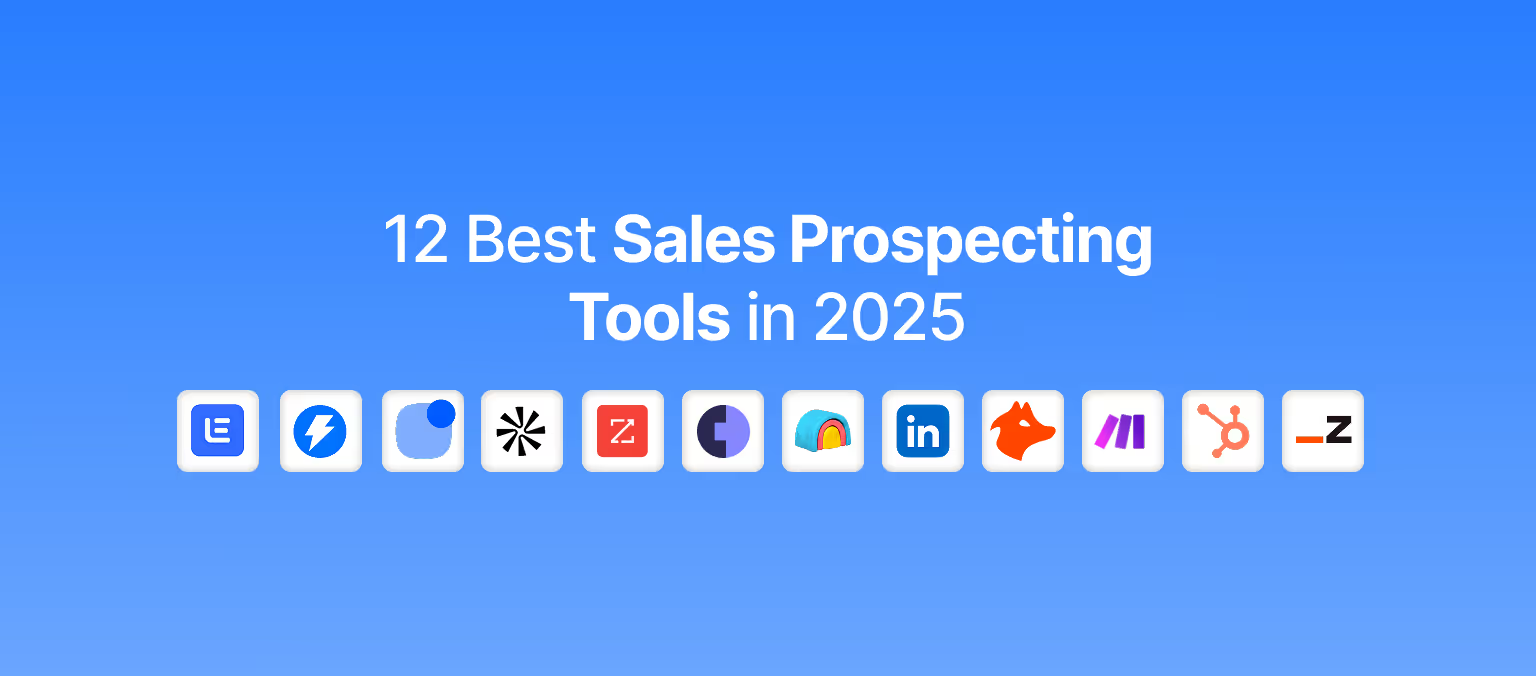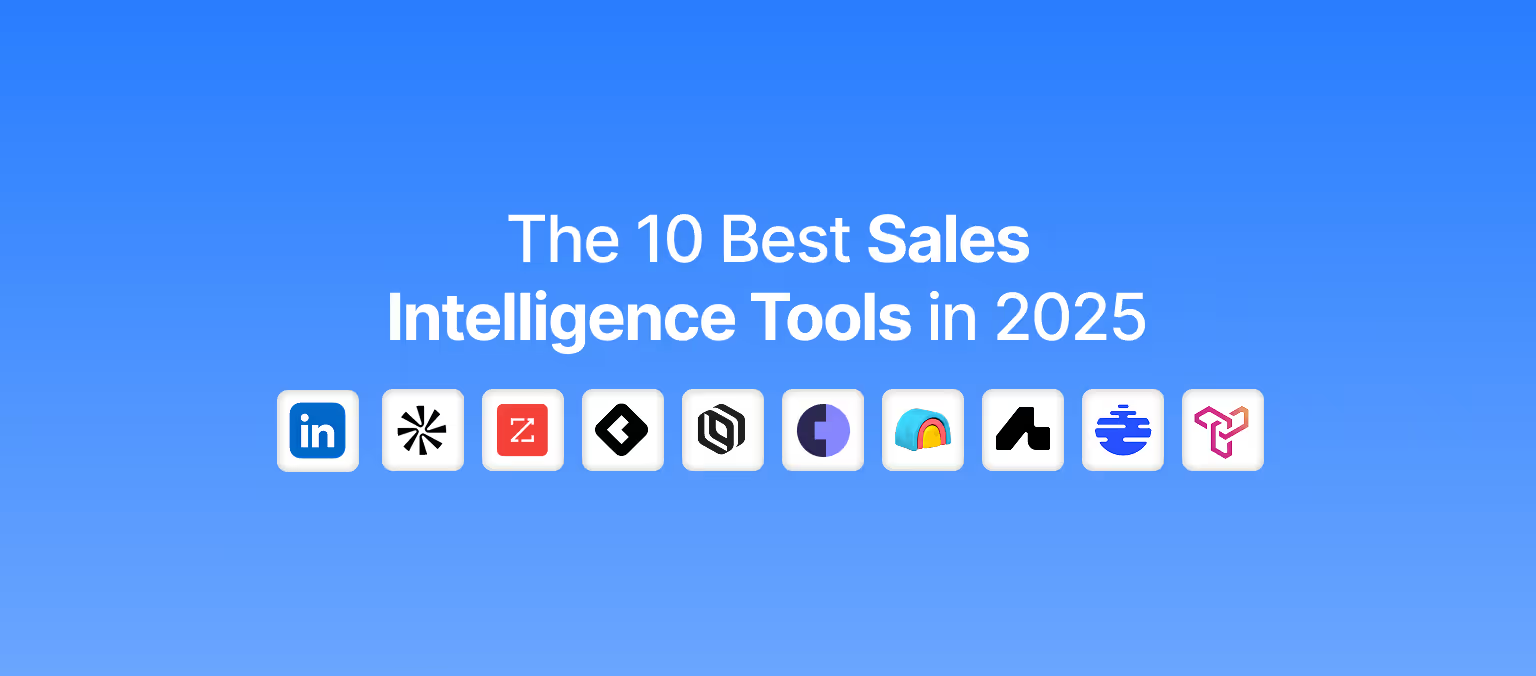14 Best Sales Automation Tools in 2025
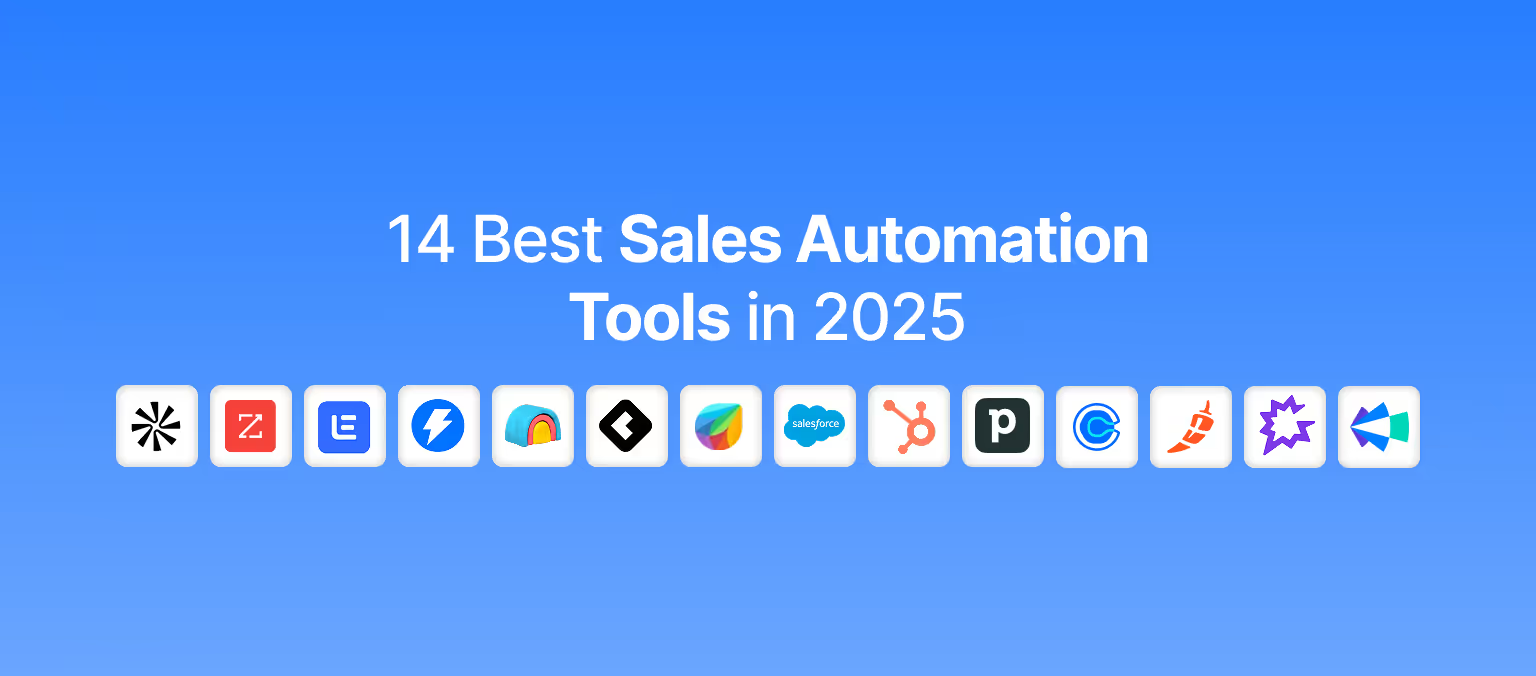
Table of content
Share article
Let’s admit this – the right sales automation tool will automate the repetitive tasks in your sales process, allowing you to focus on what matters most — closing deals.
No, we don’t mean sales automation tools that require time-consuming setup, have clunky interfaces, and integrate poorly with third-party platforms. We focus on tools that save time, boost productivity, and grow your pipeline.
In this guide, we’ve rounded up the best 14 sales automation tools you can leverage in 2025 to skyrocket your business growth. Let’s get started.
What are Sales Automation Tools?
Sales automation tools are software that automate, streamline, and optimize repetitive tasks in your sales process, enabling your team to focus on high-value activities such as building relationships and closing deals.
Think of it as your sales team’s support system handling manual labor, such as:
- Qualifying leads based on behavior or data → Automation
- Crafting personalized messages one by one → Automation
- Following up warm leads manually → Automation
- Manual data entry into the CRM → Yeah, you got it. Automation
That said, let’s explore three benefits of sales automation for sales professionals.
Time-saving
Given that salespeople spend less than 30% of their time actually selling, it’s no surprise that these administrative tasks inhibit productivity, affecting revenue growth. However, sales automation tools can help solve this problem by automating manual tasks, which saves time and allows teams to focus on other high-value tasks.
Increased revenue

Rather than updating spreadsheets and chasing approvals, sales reps can spend more time understanding the prospect’s needs, crafting compelling messages, and building relationships, ultimately driving revenue growth.
Scalability
With repetitive tasks automated, prospects can receive timely, more relevant communications. This creates a repeatable process that anyone on the team can use to engage prospects consistently, ensuring nothing falls through the cracks.
Common Use Cases
Sales automation covers the entire sales process. Here are some common use cases where sales teams can leverage automation.
- Lead generation and qualification: A sales automation tool automatically captures leads from various sources, qualifying them based on demographics and behavior, and routing them to the right salespeople. This allows you to tailor your efforts to the most relevant leads who can make the most significant impact
- Email outreach and follow-up: With sales automation, you don’t have to waste time personalizing messages and following up on prospects. Instead, you can manage thousands of prospects’ communications at once, while delivering relevant messages that engage them.
- Pipeline management: Want to know why your deals get stuck without guesswork? Sales automation reveals bottlenecks, tracks deals, and provides accurate forecasts of stage progress, enabling you to manage leads effectively.
Core Features to Look for in a Sales Automation Tool
1. Lead capturing and scoring
A sales automation tool with an AI sales prospecting feature can help identify and qualify leads within minutes, reducing the time spent on manual approaches.
2. Email sequencing and outreach automation
Many outreach processes consist of three stages: crafting personalized leads, reaching out to prospects via multiple channels, and conducting follow-ups. Handling these tasks manually leaves you exhausted, as 41% of SDR leaders cite messaging as the biggest challenge of their work. However, sales automation can automate tasks that consume a significant portion of their day, allowing them to focus on other relevant sales activities.
3. CRM integration and contact management
A sales automation tool that doesn’t integrate seamlessly with your existing tech stack will disrupt your workflow. For instance, rather than auto-updating your leads' details or contact information, sales reps would have to manually save the details, wasting their time and inhibiting efficiency. However, finding a tool that integrates seamlessly with CRMs and auto-syncs your leads' details, enabling you to manage contracts effectively, is crucial.
4. Analytics and reporting capabilities
Your sales automation tool should enable you to track sales performance through key performance indicators (KPIs), such as response rates, email open rates, click-through rates, and more. With these metrics, sales teams can identify what’s working and the areas that need improvement, and refine their strategies for better results.
ColdIQ - Your Best Partner for Scalable Sales Automation
Think about this. You have many sales automation tools in your tech stack, but you’re not harnessing their full potential. You waste hours trying to find qualified leads with Lemlist’s database, miss out on buying signals from Common Room, and fail to personalize messages for your audience.
The problem isn’t the tool; it’s your strategy. This is why you need a partner that leverages the tools effectively and implements the right strategy to fill your pipeline with qualified opportunities. At ColdIQ, we don’t just run software. We’re your dedicated sales automation partner, bringing the expertise, systems, and relentless focus, while you focus on what matters most — closing deals and growing your business.
When you partner with us, here are the offers you get:
- ICP research that goes beyond LinkedIn searches
- Personalized messaging that stands out from other cold emails in your inbox
- Multi-channel sequences across emails, calls, and LinkedIn
- Email infrastructure to land your emails in the inbox, not spam.
The Result We Get
We aren’t just after the numbers. Our clients typically encounter consistent lead opportunities that have a high conversion rate. For instance, we partnered with Peoplelogic, a performance platform, and generated 250 leads per month with a 40% conversion rate.
Similarly, we partnered with Novel, an e-commerce solution, and generated 5-8 leads per day through our cold email campaigns. With our outbound system, we deliver what matters most to you: a sustainable, predictable pipeline growth that compounds day by day to drive revenue for your business.
14 Best Sales Automation Tools
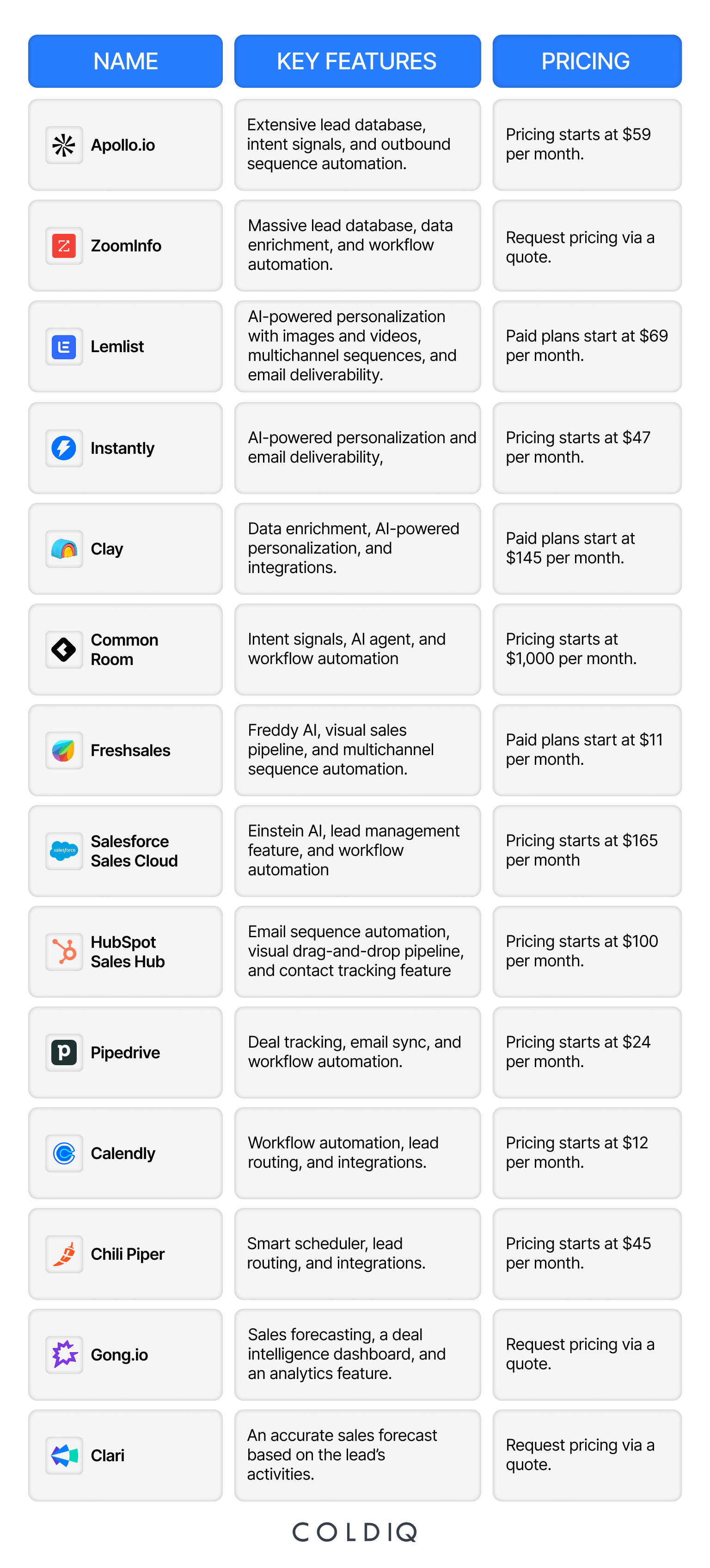
A. Lead Generation & Prospecting
1. Apollo.io – Enriched B2B contact database with built-in email outreach

If your goal is to find qualified leads, personalize messages at scale, and convert your ideal buyers without switching tabs, Apollo is your best shot. One of its standout features is its lead database, which offers over 210 million contacts and more than 65 precision filters, enabling you to connect with decision-makers and create a targeted list.
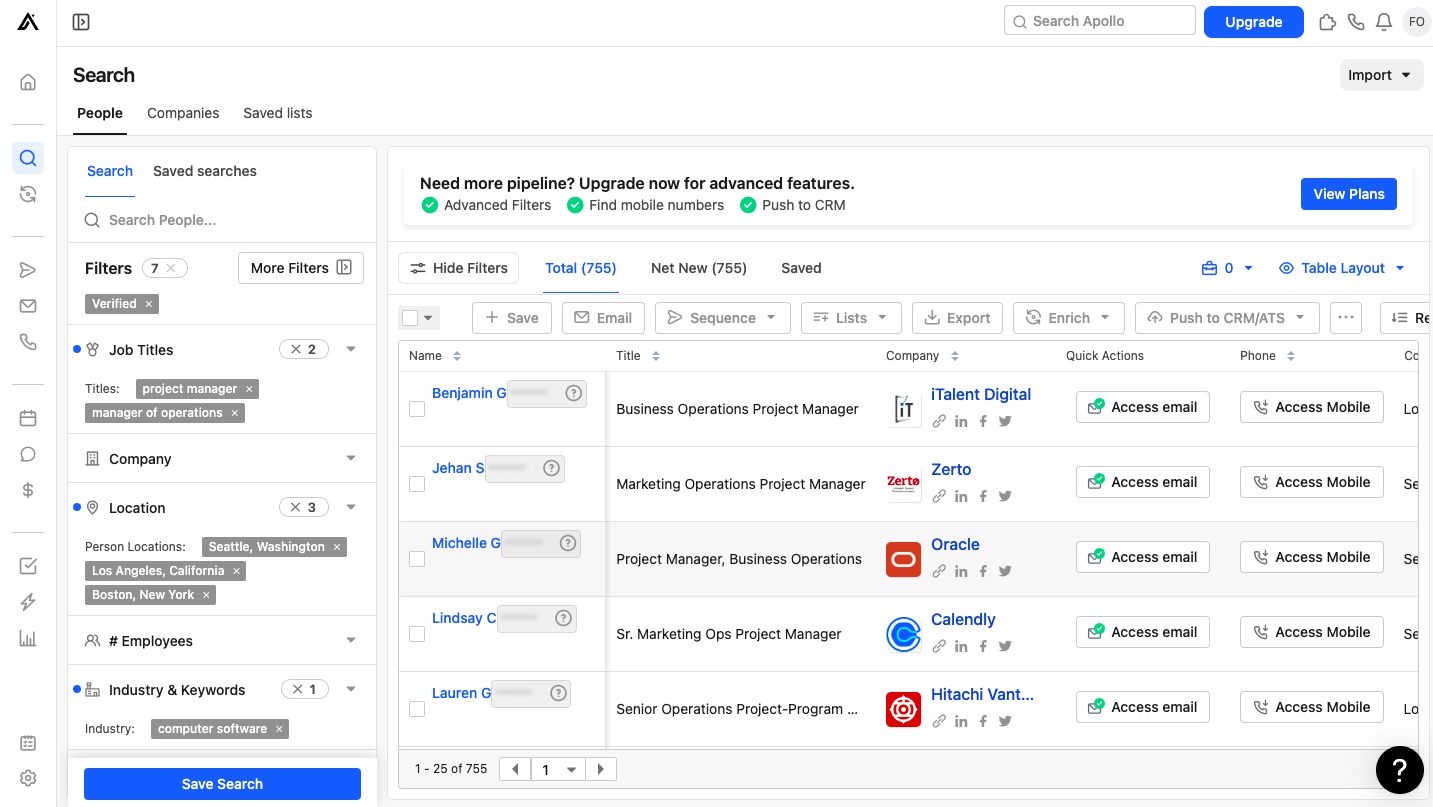
Another feature that’s useful to salespeople is the engagement feature, which allows you to automate outbound sequences. You can craft personalized messages, make phone calls, connect with prospects on LinkedIn, and track engagement. On top of that, manual data entry is no longer your worry, as you can enrich your CRM automatically with accurate data on the platform.
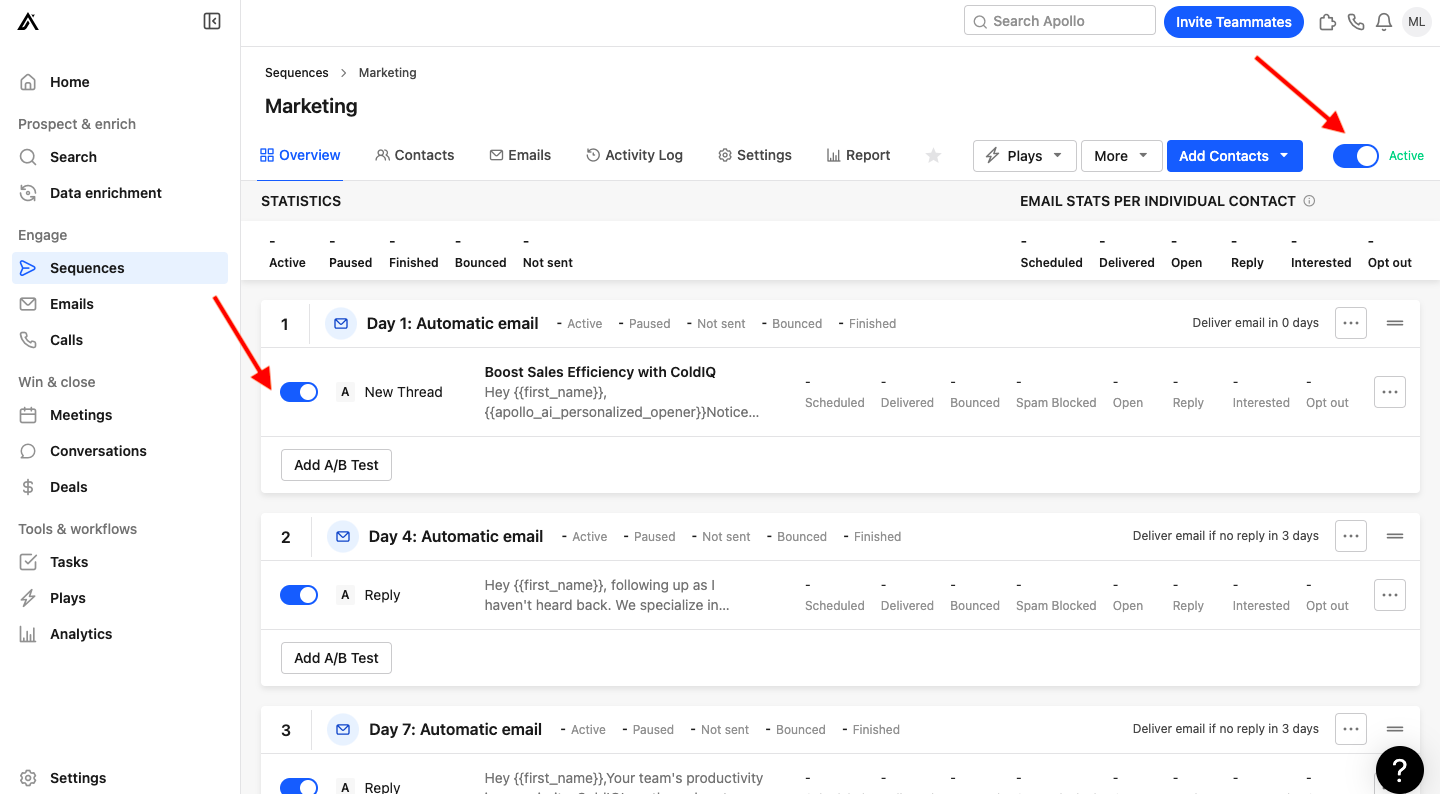
Without a doubt, Apollo stands out for its all-in-one advantage, extensive database, multi-channel sequences, and CRM enrichment, which allow you to launch your cold campaigns at scale. Besides, its affordable pricing makes it ideal for startups and small businesses seeking to set foot in the cold email industry.
Pros
- Allows you to find leads fast.
- Integrates seamlessly with third-party platforms, streamlining your workflow.
Cons
- Deliverability can suffer if emails aren’t warmed up properly.
- Some advanced features require a steep learning curve, which may not be suitable for beginners.
Pricing
Apollo offers a free plan with limited credits, but its paid plans start at $59 per month.
2. ZoomInfo – Powerful data platform for finding and qualifying high-intent leads

Another lead generation and prospecting tool out there is ZoomInfo. Similar to Apollo, its vast database and search filters allow you to find specific contacts and targeted companies in niche industries or international markets.
Apart from this, the leading GTM intelligence platform offers real-time buying signals that allow you to target prospects beyond mere demographic filters. For instance, you could easily identify the anonymous visitors landing on your site due to its web visitor signals or identify hiring trends that could signal new opportunities.
Unlike other tools, what sets ZoomInfo apart is its quality data and real-time updates. It consistently updates its database to provide accurate information that will advance its users’ prospecting efforts. In short, you don’t have to waste time on a lead that isn’t interested in your offerings and won’t convert.
Pros
- Allows you to find leads quickly
- Provides real-time insights to engage prospects efficiently.
Cons
- There is no free trial to explore the tool’s features.
- Pricing may be overwhelming for startups or small businesses.
Pricing
Contact the sales team for a quote.
B. Cold Outreach & Email Sequences
3. Lemlist – Ideal for cold email at scale with multi-channel outreach and automated follow-ups (email + LinkedIn)

Lemlist screams cold outreach. Even its homepage has “multichannel outreach” + “replies,” letting you know it’s all for engagement. One of its fortes is that you can customize your message with different variables — email, first and last name, company name, LinkedIn URL, images, videos, and more — to engage your audience and increase the likelihood of receiving a response from your prospects.
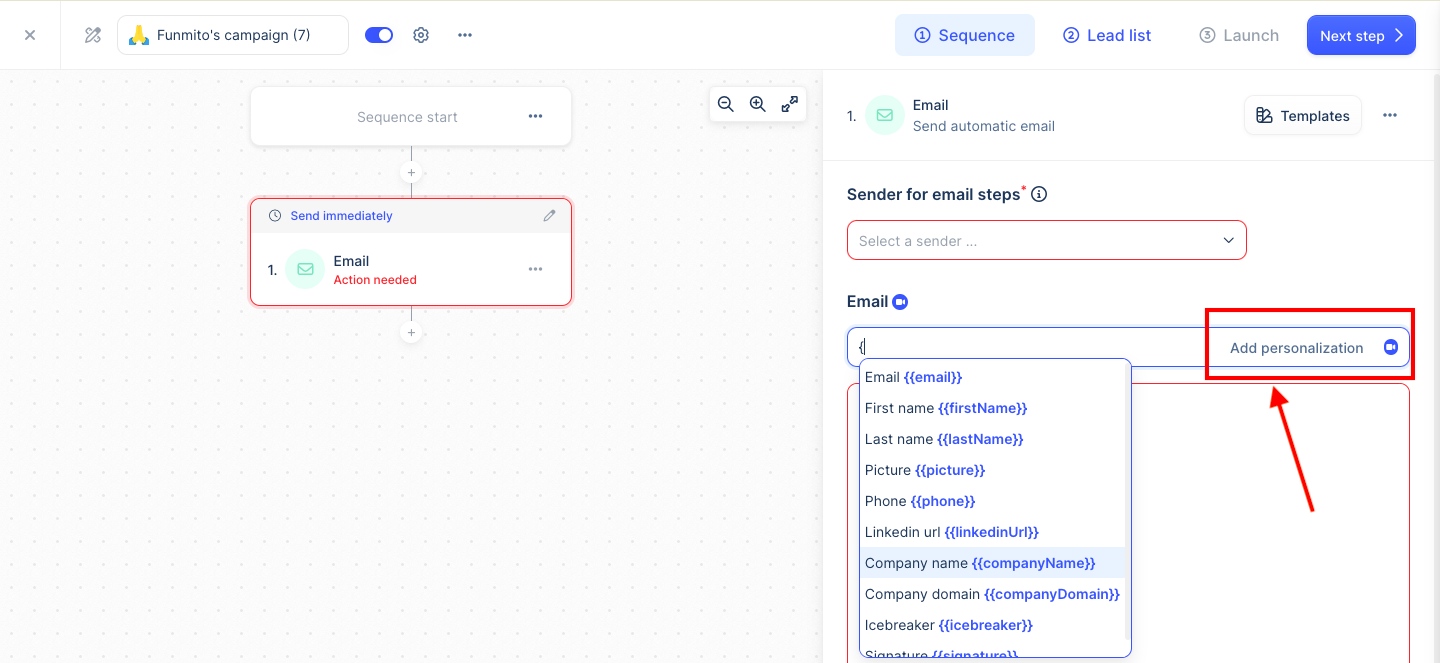
You can also engage your prospects across multiple channels, expanding your reach among your preferred audience. Lemlist stands out for its bold mix of automation and personalization at scale. With real-world templates and playbooks, engaging your prospects becomes less of a chore and instead, a task you’re excited about.
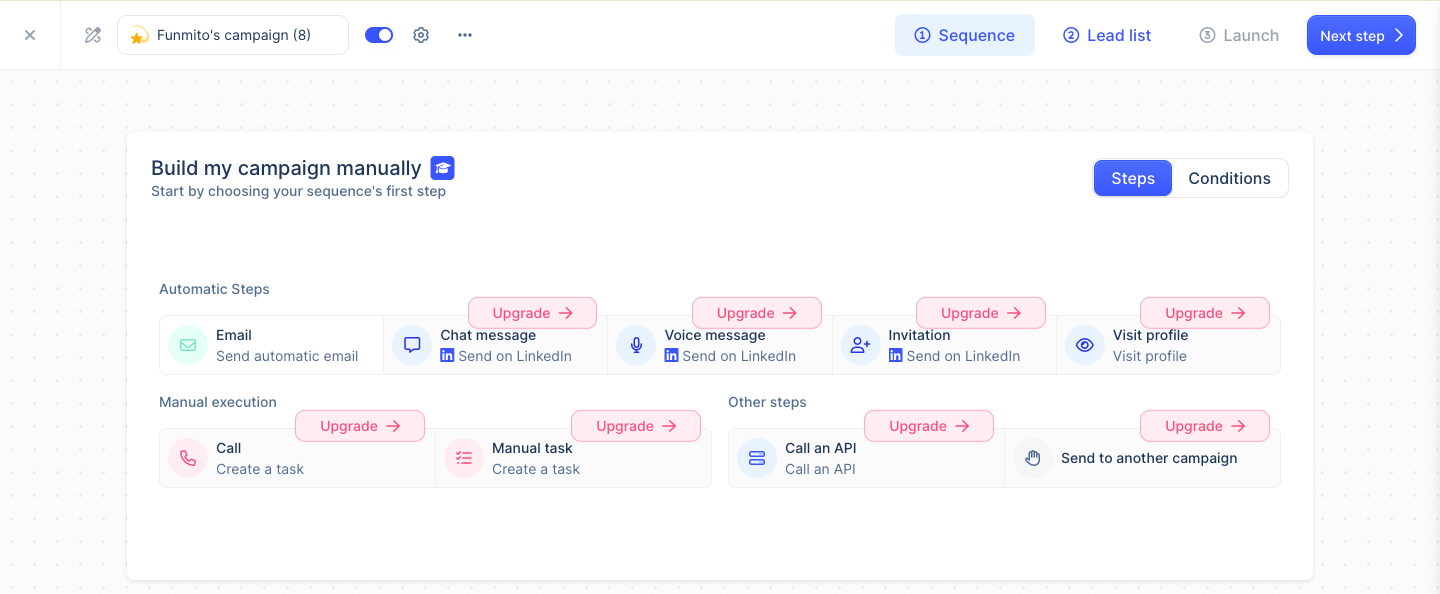
Pros
- A user-friendly interface that allows you to perform any outreach activity with a few clicks.
- Strong on personalization to engage prospects.
Cons
- Users report technical glitches when using the app.
- Users criticize the company’s poor customer support when issues need to be resolved.
Pricing
Lemlist offers a 14-day free trial, but its paid plans start at $69 per month.
4. Instantly – Designed for cold email at scale with automated outreach and deliverability
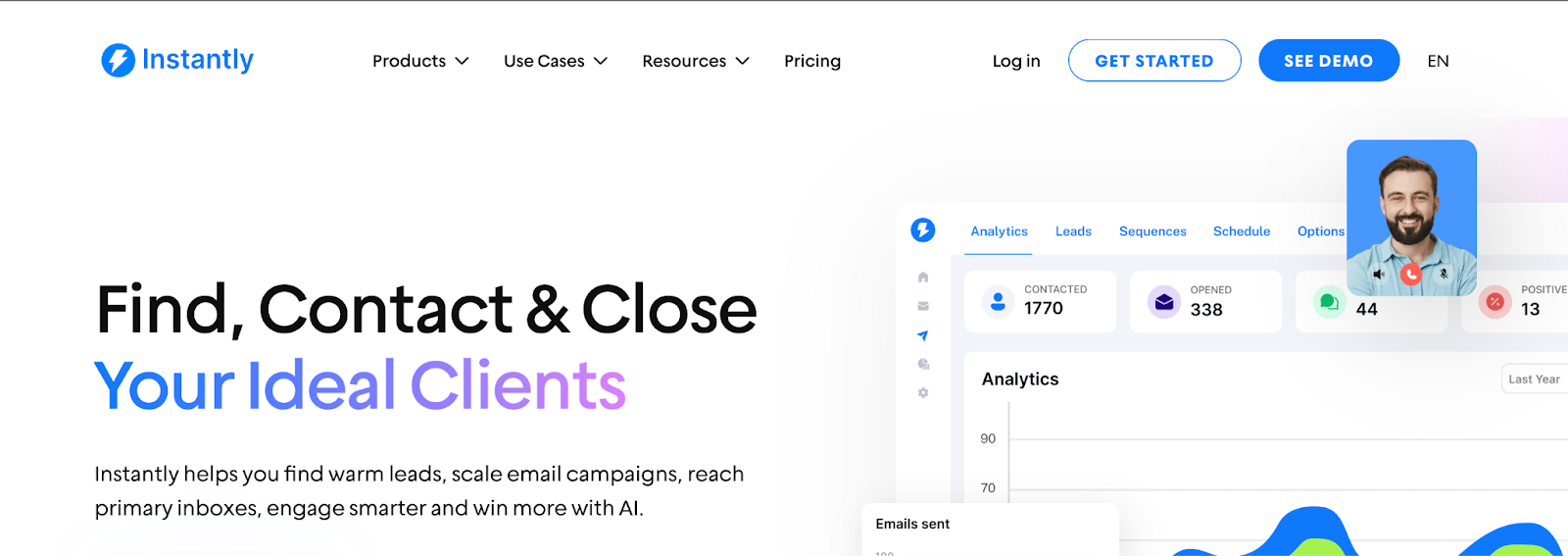
Instantly is well-known in the cold outreach industry. Similar to Lemlist, the cold email outreach platform is renowned for auto-generating personalized campaigns with custom variables to engage prospects.
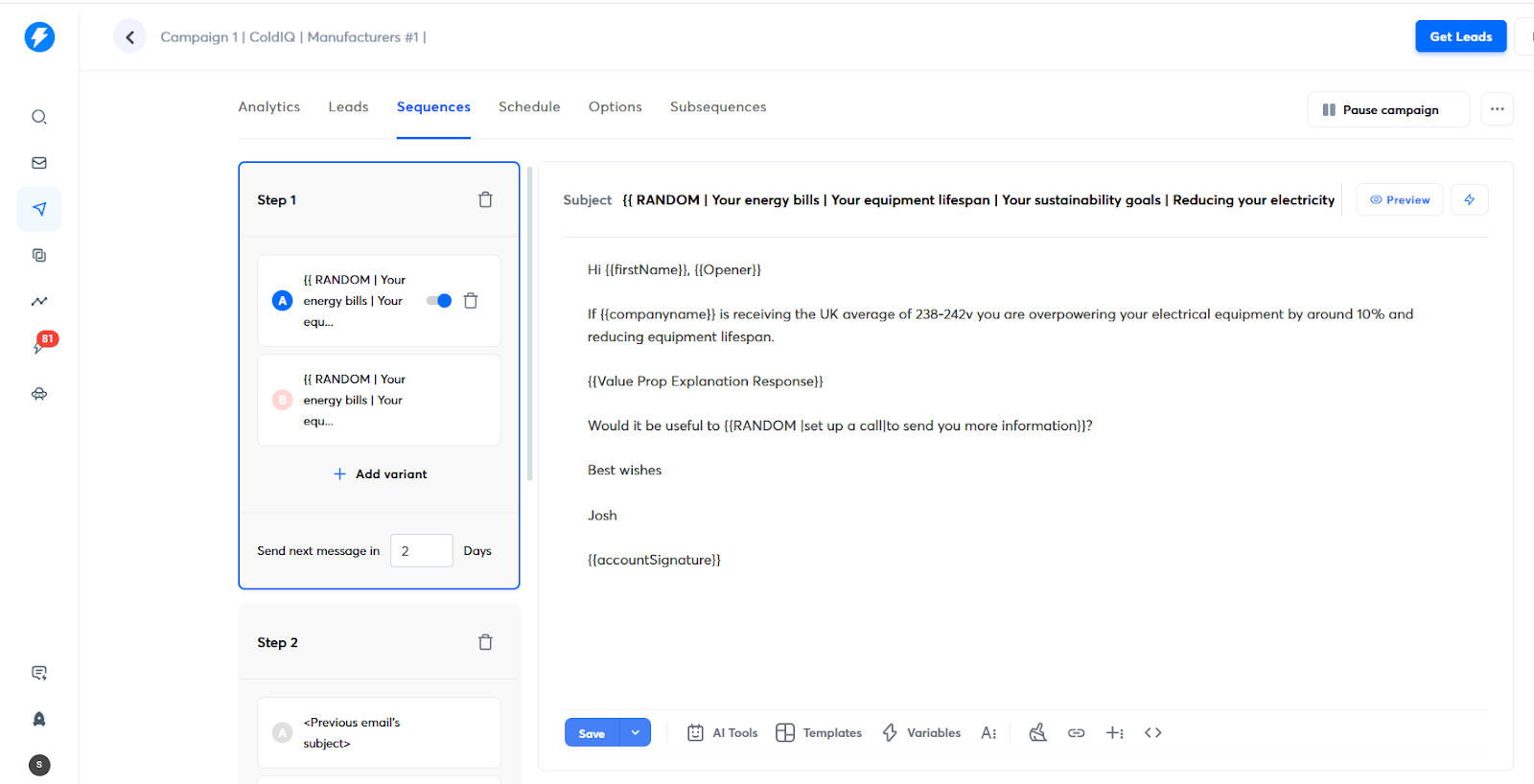
However, what makes the tool stand out is its deliverability approach. Unlike other outreach tools, Instantly isn’t afraid of volumes. You can run hundreds of campaigns from a single dashboard, warming and rotating emails to land in your prospect’s inbox. With unlimited mailboxes, it’s ideal for sales teams and agencies seeking to reach their prospects on a large scale.
Pros
- Create personalized messages at scale.
- Send high-volume cold emails with excellent deliverability.
Cons
- No multi-channel sequences to reach prospects.
- Limited integrations with third-party tools like CRMs, email outreach tools, scheduling platforms, and more.
Pricing
Instantly’s pricing plans start at $47 per month.
C. Data Enrichment and Intent Signals
5. Clay — Maximize data coverage and obtain intent signals
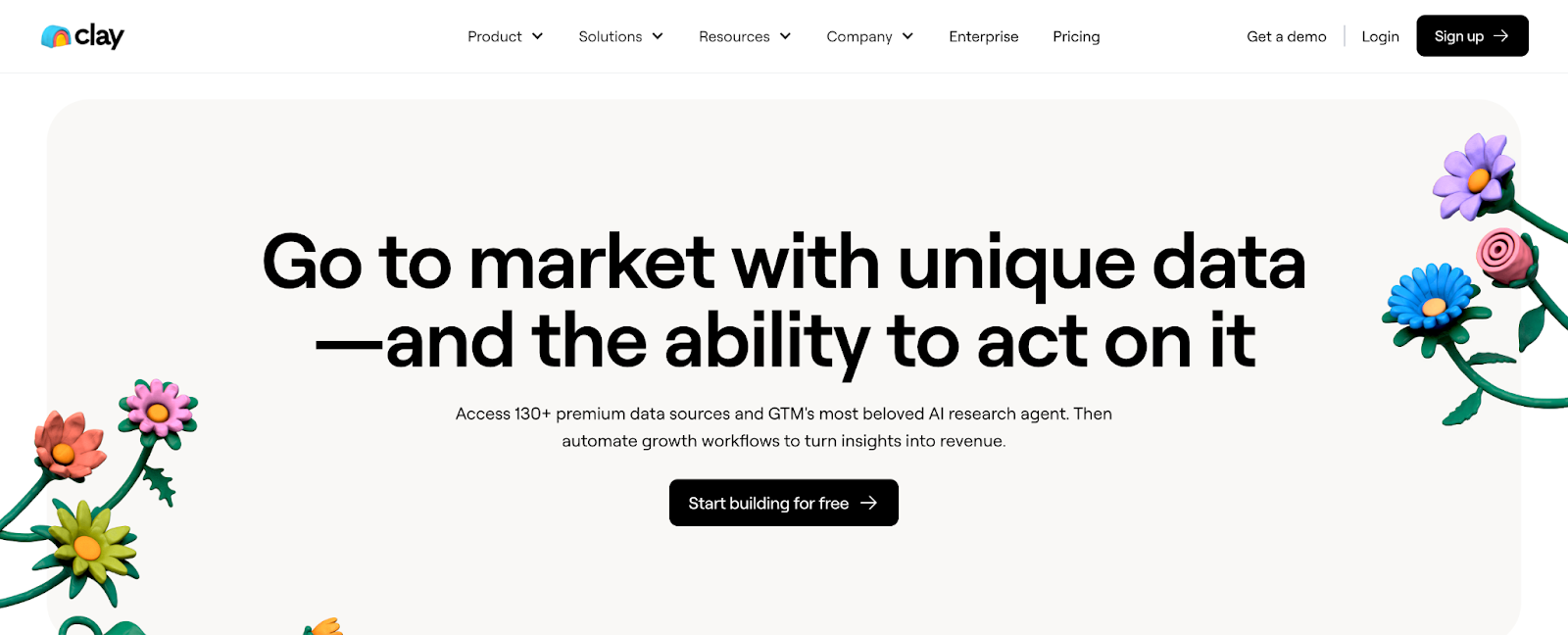
Clay is renowned for waterfall enrichment. With logic, conditions, filters, and automation, you can pull data from over a hundred sources in a spreadsheet-like interface. For instance, you can find accurate contact data (email addresses and phone numbers) from over 100 sources to reach your prospects. Here’s how it works: if it doesn’t find data from a vendor like Prospeo, it searches another vendor, such as Clearbit, to obtain the data you want.
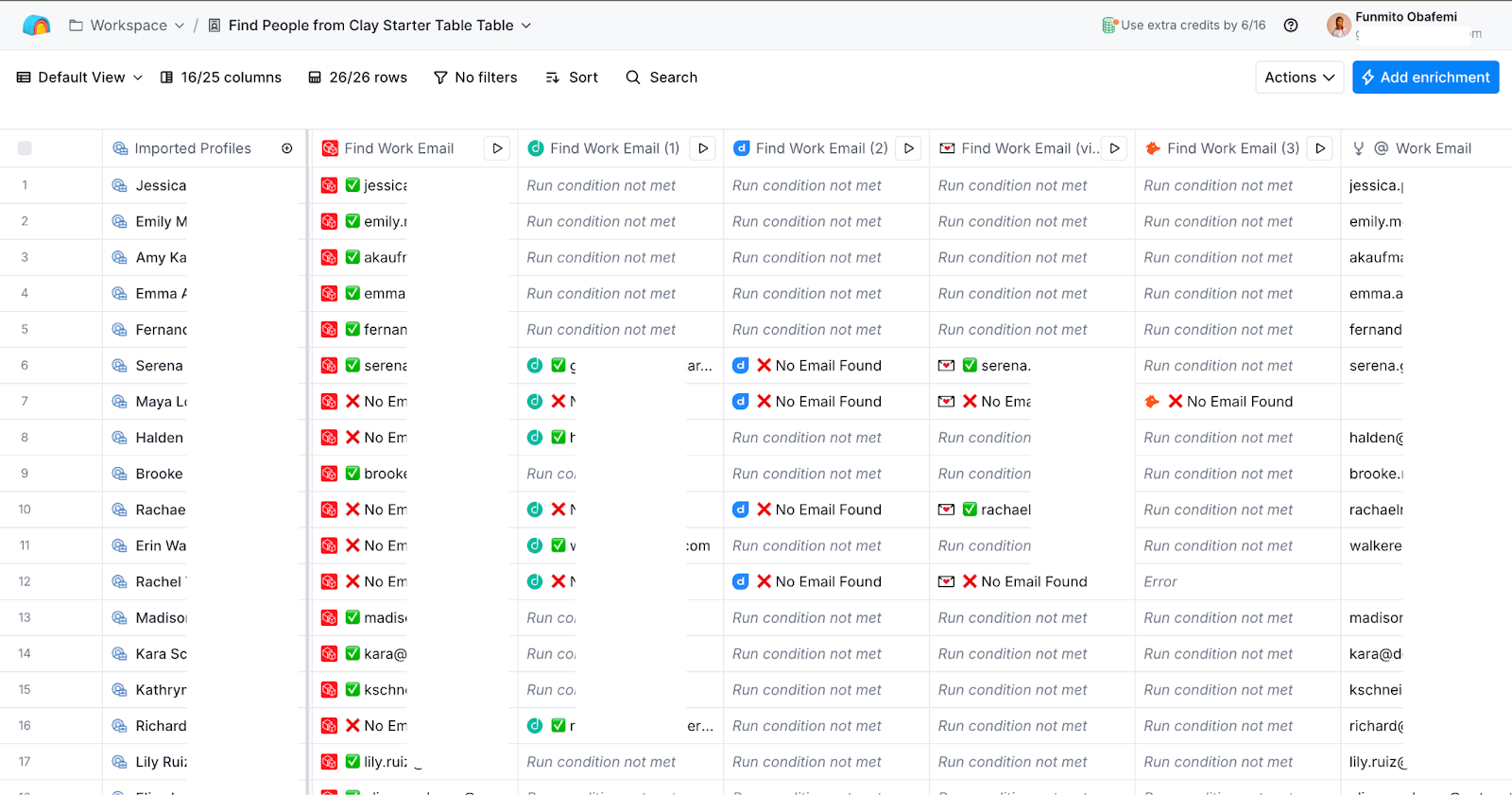
You can also use its AI research agent to obtain information from any corner of the internet. For instance, you can use it to check if a company is hiring, the number of funding rounds they’ve had, their pricing model, or anything that comes to your mind during prospecting. In this article, we illustrated how to use Claygent to find and output data in the format that you want.
Aside from the waterfall enrichment, Clay is also known for its flexibility. You can run your own logic, obtain data from various sources, and generate outreach at scale.
Pros
- It’s flexible and customizable for any outbound use case.
- Automated workflow to improve sales operations.
Con
- A credit-based pricing model can become expensive if not utilized appropriately.
Pricing
Clay offers a free plan with limited credits, but its paid plans start at $149 per month.
6. Common Room — Get buying signals and obtain actionable intelligence from AI

Common Room is a community intelligence and sales automation platform designed to provide teams with valuable buying signals that convert into sales opportunities. Unlike other tools that focus on mass email blasts or cold calls, Common Room surfaces real engagement from over 50 sources — Slack threads, social media mentions, and website visits — and maps those signals to real accounts.
Like Clay, Common Room also has an AI sales agent, Roomie AI, that helps to streamline your sales processes, automating prospect prioritization and lead scoring without human touch. On top of this, the tool is renowned for personalizing messages with outbound signals to create a resonating effect on prospects. Overall, Common stands out for aggregating signals from different sources to provide a complete picture of a prospect’s buying intent.
Pros
- Provides valuable buying signals that other platforms may miss.
- Helpful customer support to address queries and resolve issues.
Cons
- Limited customization
- Missing functionalities such as A/B testing capabilities, data transfer, and more.
Pricing
Common Room’s pricing plans start at $1,000 per month.
D. Lead Scoring & Qualification
7. Freshsales (by Freshworks) – AI-powered lead scoring based on behavioral data.
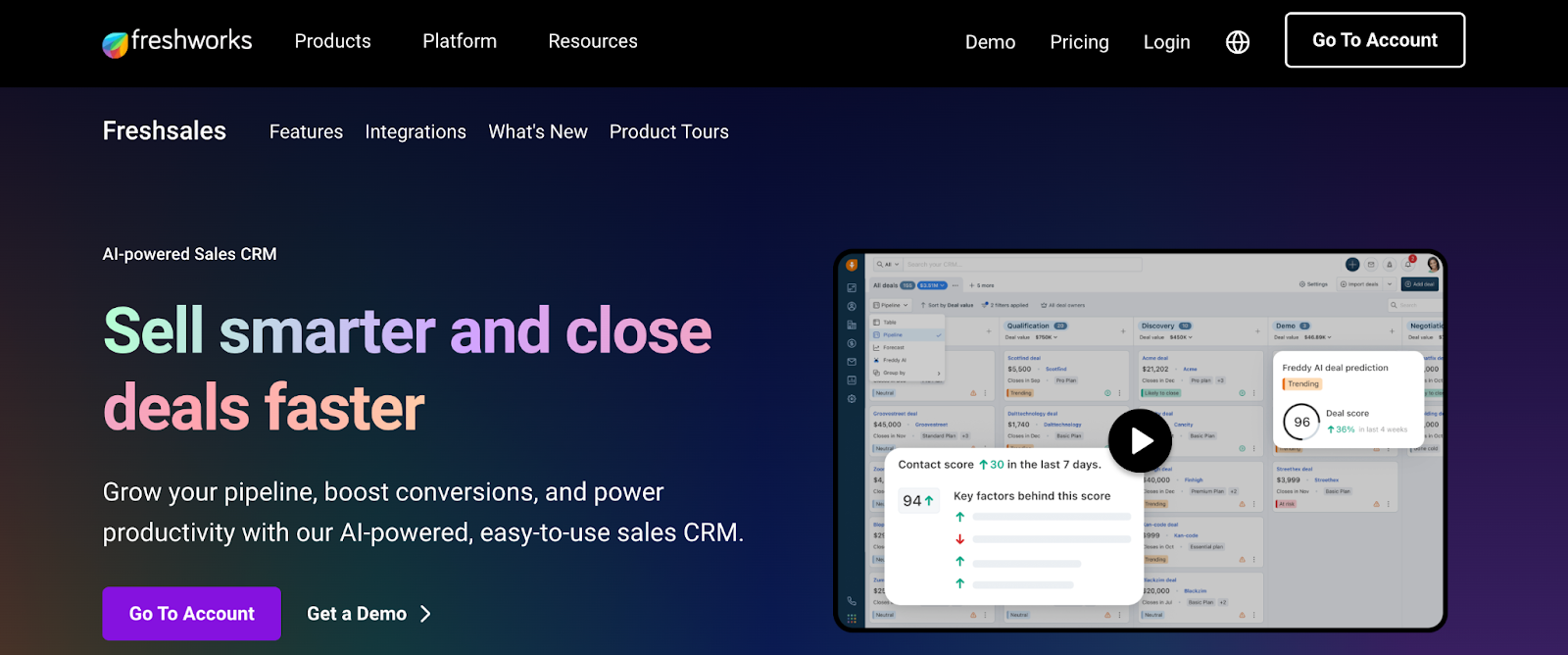
Freshsales is a complete CRM and sales automation solution for small to mid-sized businesses. It’s highly customizable, with a clear focus on lead management and scoring. Freshsales doesn’t treat all leads as the same. It employs its AI-powered lead scoring model to surface insights, so you can prioritize prospects who are ready to buy.
Plus, pipeline management is one of its core strengths, enabling you to track every touchpoint, automate follow-ups, and provide a comprehensive view of your lead’s progress to move the deal forward.
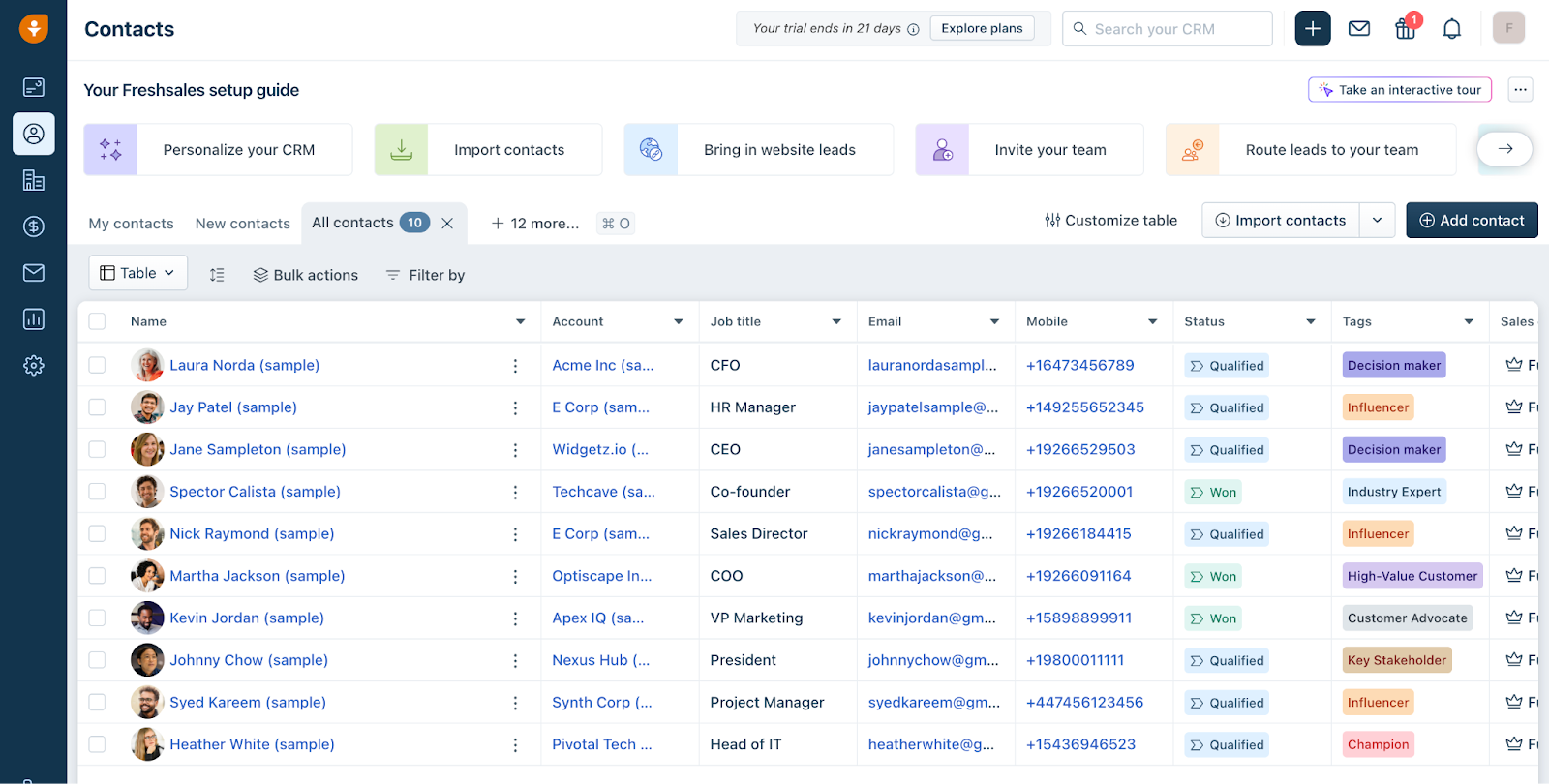
Freshsales stands out for its user-friendly interface which offers a visual representation of your pipeline and its progress, allowing you to manage deals more effectively.
Pros
- Intuitive interface that requires less onboarding time.
- Strong automation to streamline all sales activities.
- Pricing is great for small teams and mid-sized businesses.
Con
- Some features, like advanced reporting, may feel limited for enterprises.
Pricing
Freshsales offers a 21-day free trial, but paid plans start at $11 per month.
8. Salesforce Sales Cloud – Highly customizable scoring models and integrations.
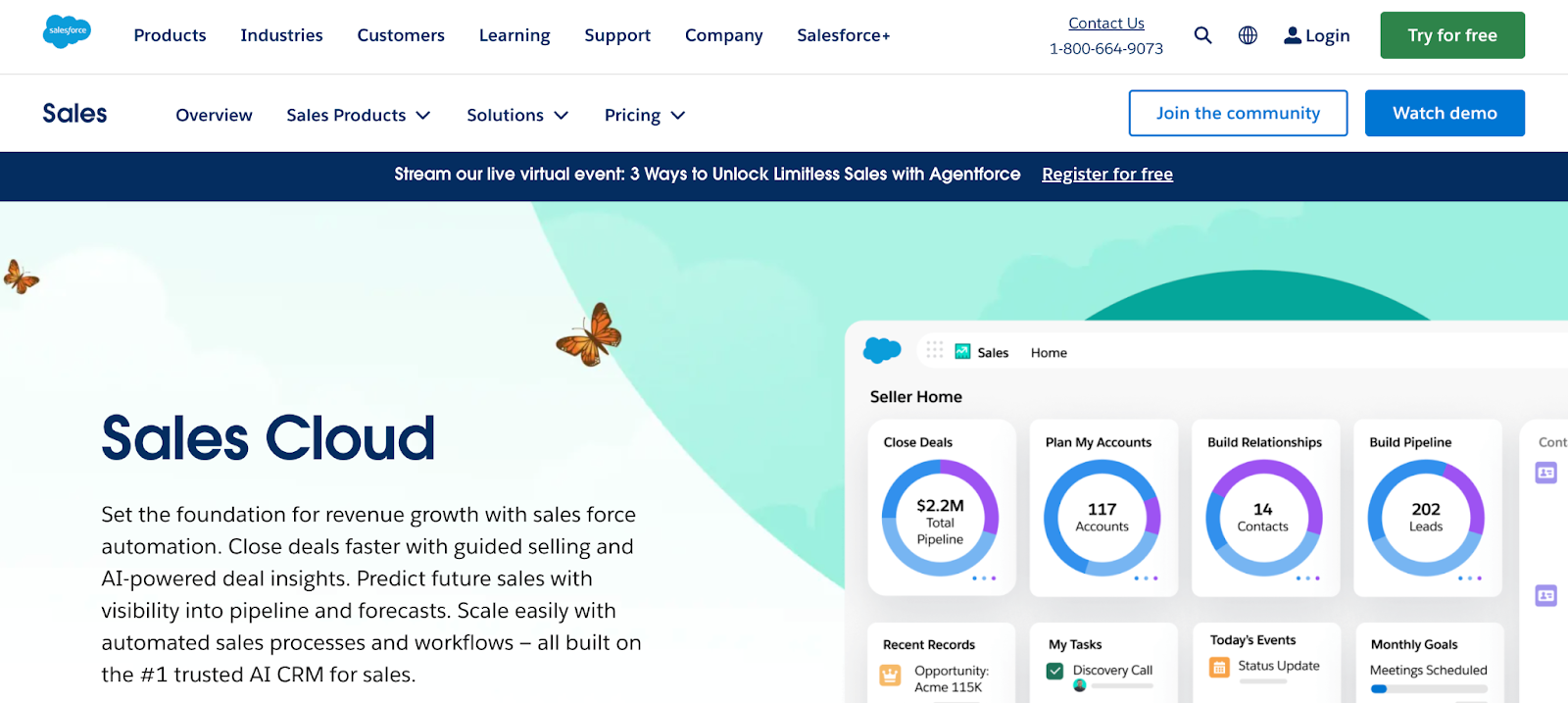
Sales Cloud, a part of the Salesforce ecosystem, is a CRM and cloud-based sales automation platform designed to help teams manage the entire sales lifecycle, from lead capture to closing deals. Beyond managing leads, Sales Cloud is also renowned for its lead-scoring feature. Whether you source leads from webinars or paid campaigns, the platform automatically assigns scores, routes the right sales rep, and automates workflow to accelerate response time.
What sets Salesforce apart is its agentforce, Einstein AI, that leverages its insights to predict which leads will close and suggest the next best action. Plus, Salesforce works best for enterprises due to its deep customization options and robust security features.
Pros
- Offers deep customization for enterprises.
- Integrates seamlessly with third-party platforms like Slack or other marketing automation tools.
Cons
- It’s not suitable for smaller businesses due to its steep learning curve and complex features.
- It becomes expensive when scaling with advanced features.
Pricing
Sales Cloud pricing starts at $165 per month/user
E. CRM and Pipeline Management
9. HubSpot Sales Hub – Robust, user-friendly CRM with automated workflows.
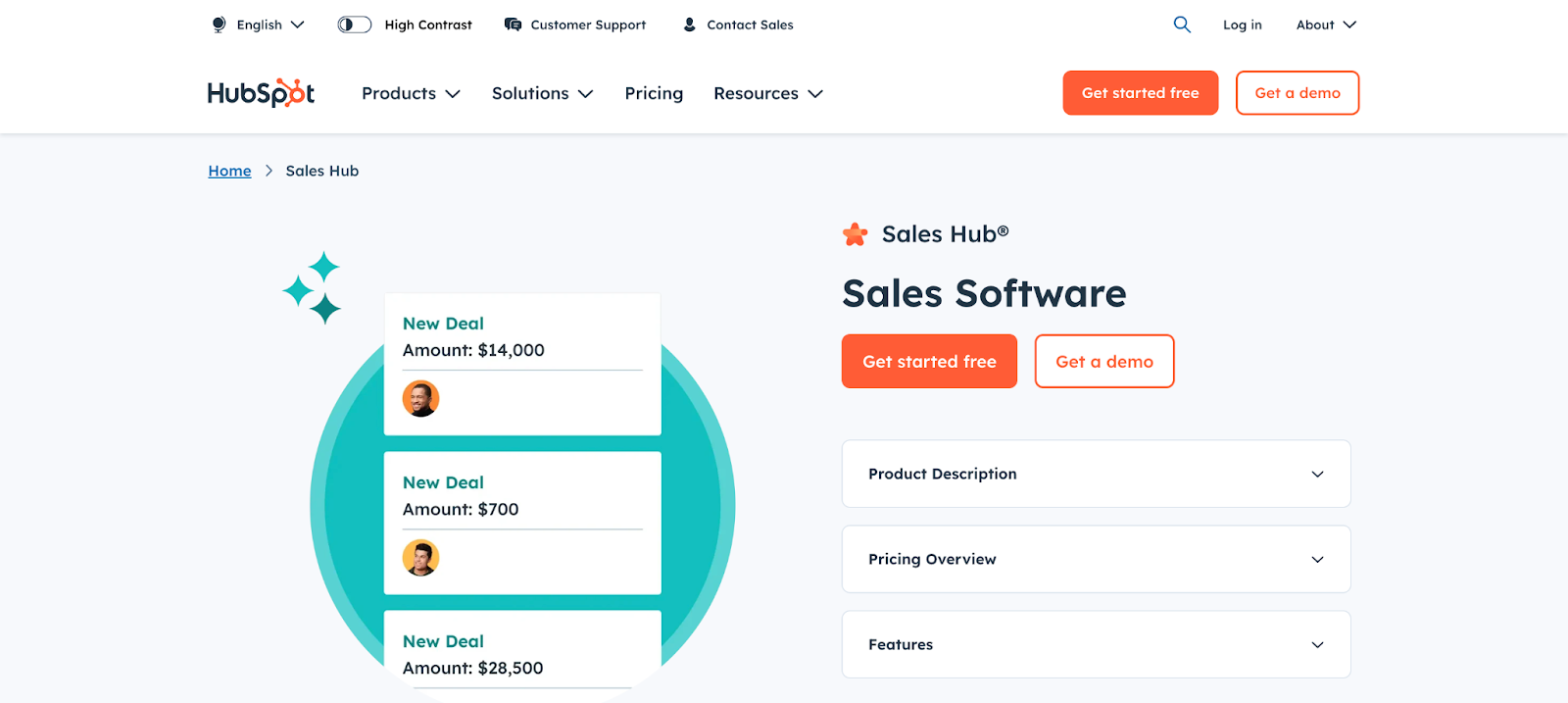
HubSpot Sales is a powerful, all-in-one customer relationship management (CRM) and sales automation platform designed to help teams attract, engage, and close deals more efficiently. Thanks to its conversation intelligence feature, every sales conversation with a lead or client automatically syncs with the CRM, linking the relevant intelligence to the corresponding customer record. In other words, you don’t have to switch between platforms to record insights manually.
Furthermore, HubSpot stands out for its robust workflow automation capabilities, enabling you to manage leads, create deals, and automate tasks at your own convenience. Unlike Salesforce, you don’t need to spend much time mastering its functionalities. With an intuitive interface, you can cultivate a stronger relationship and supercharge your sales efforts.
Pros
- An intuitive user interface that is easy to use and navigate.
- Powerful automation that is easy to set up.
- Integrates seamlessly with third-party platforms to streamline your workflow.
Cons
- The tool can get more pricey as you scale.
Pricing
HubSpot’s custom pricing starts at $100 per month/user
10. Pipedrive – Visual pipeline with automated task scheduling and follow-up reminders.

Pipedrive isn’t just about automation — it emphasizes simplicity. In one visual dashboard, you can create deals when a new contact is added, remove existing deals, or rearrange deals based on your preference. You can also add multiple pipelines to your sales process and transfer deals between those pipelines.
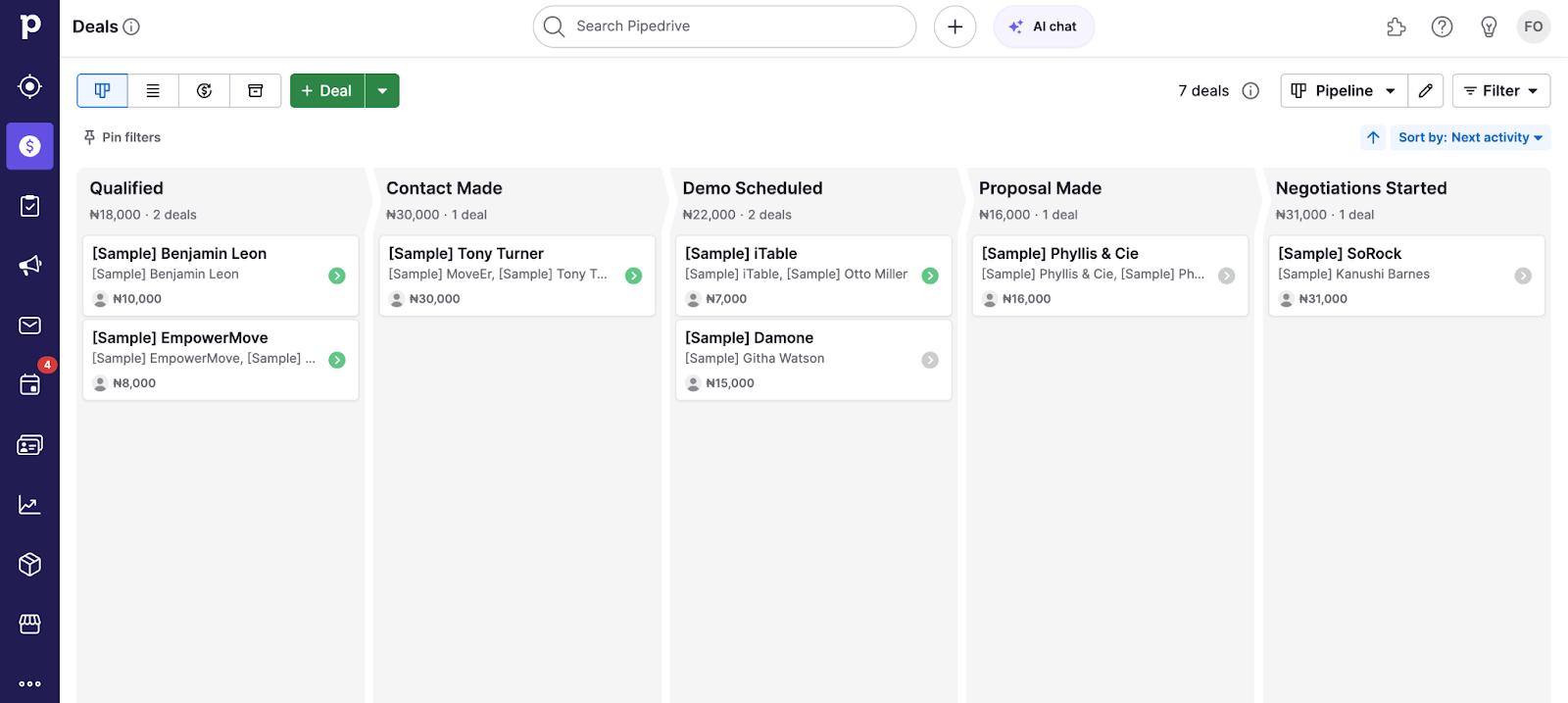
Furthermore, Pipedrive also makes email communication easy by leveraging its templates to set up your emails and use merge fields to personalize each message. This approach allows you to forge a stronger relationship with your potential customers.
Similar to HubSpot, Pipedrive stands out for its workflow automation capabilities which streamlines your workflow. Whether you need to make calls, send out personalized emails based on triggers, or move deals across your pipelines, the system automates these mundane tasks to ensure you focus on what actually matters — selling.
Pros
- Its visual pipeline allows sales teams to track deals across various stages of the pipeline.
- It automates repetitive tasks, saving valuable time for sales reps
Cons
- Reporting is not as deep as enterprise CRMs
- It’s not ideal for complex sales processes.
Pricing
Pipedrive offers a 14-day free trial, but its paid plans start at $24 per month.
F. Meeting Scheduling & Calendar Automation
11. Calendly – Simple, popular scheduling tool that integrates into outreach and CRM workflows.
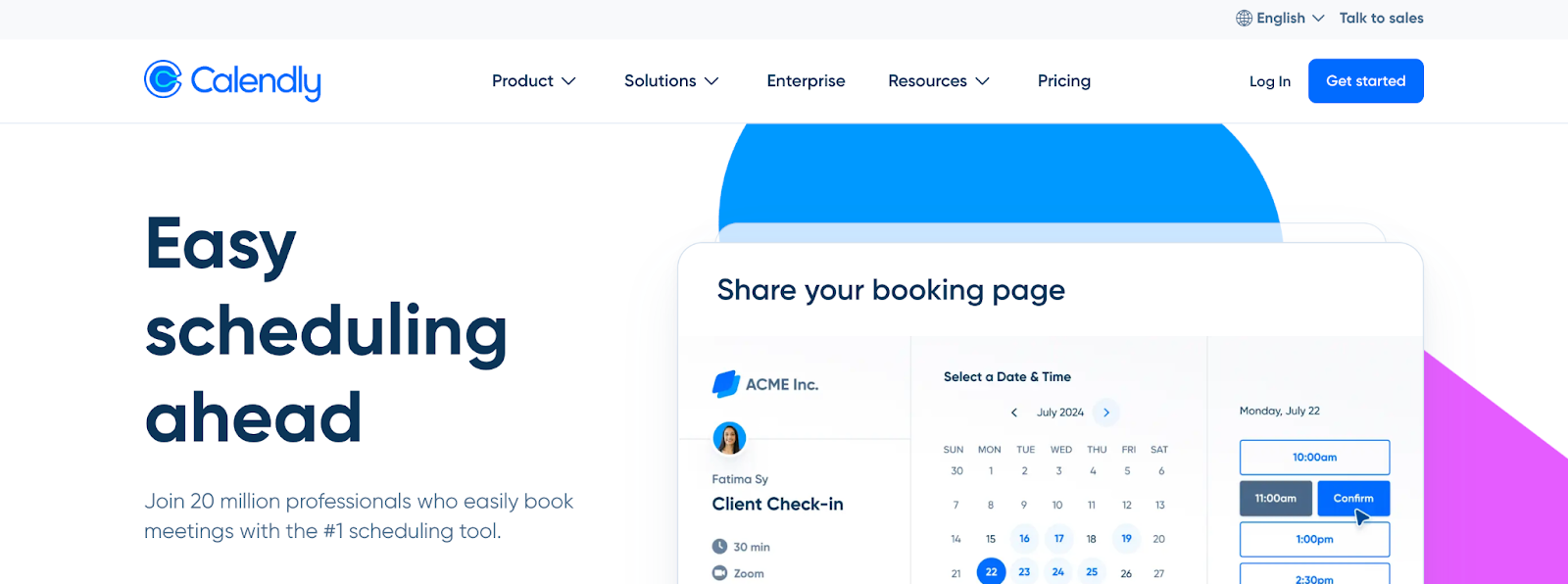
Need an automated scheduling platform that eliminates the stress involved with booking meetings? That’s Calendly. Qualified leads can schedule meetings directly from your website, eliminating the need to confirm your availability through texts or email.
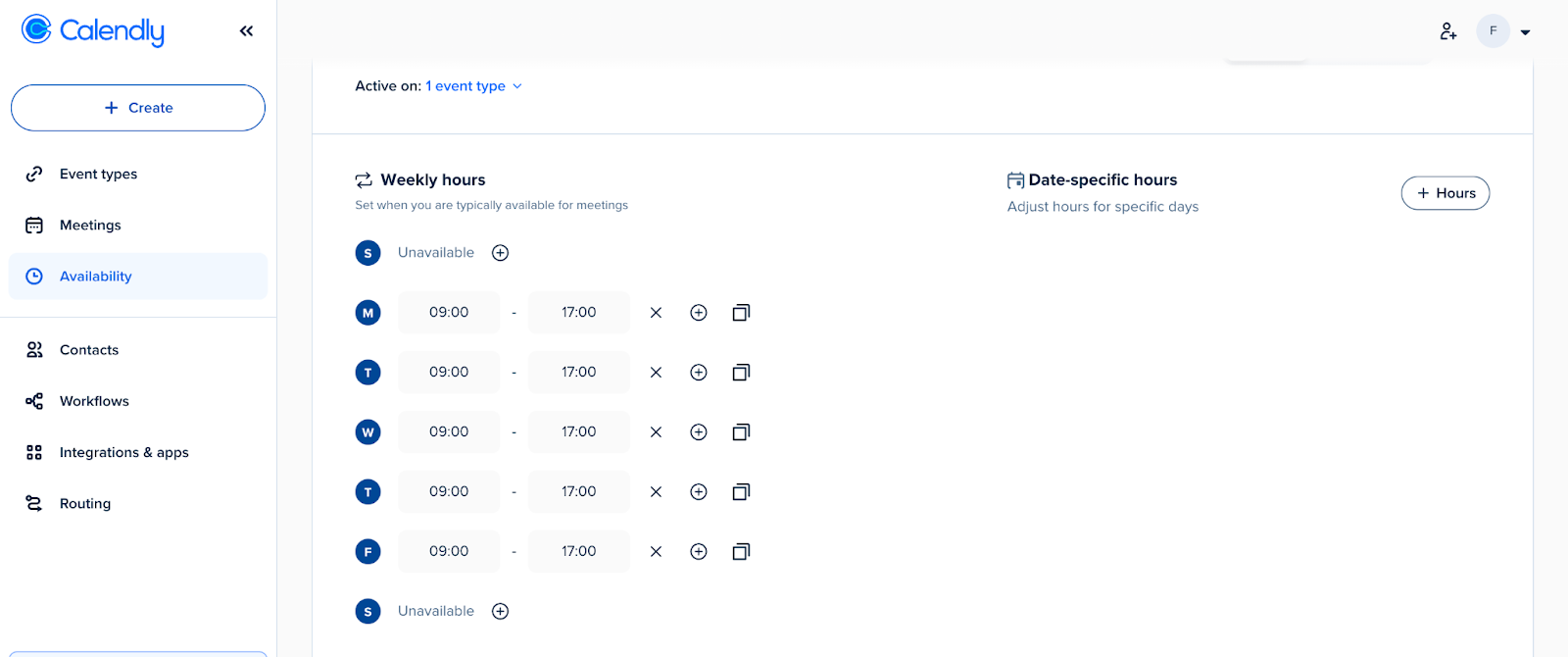
Additionally, once a prospect fills out a marketing form on your website, stating their needs, company size, industry, and budget, Calendly automatically displays the scheduling page to leads who meet your qualifications and routes them to the appropriate salesperson.
Calendly stands out for its seamless integrations with third-party platforms, including calendars, video conferencing tools, and CRMs, to streamline the scheduling process.
Pros
- It’s easy to use and implement, requiring a minimal learning curve.
- It offers a great buyer experience, especially with the high booking rates.
Cons
- Advanced features like routing require pain tiers
- It doesn’t track post-meeting outcomes or take notes.
Pricing
Calendly offers a free plan, but its paid plans start at $12 per month.
12. Chili Piper – Advanced routing and scheduling, especially for inbound leads.
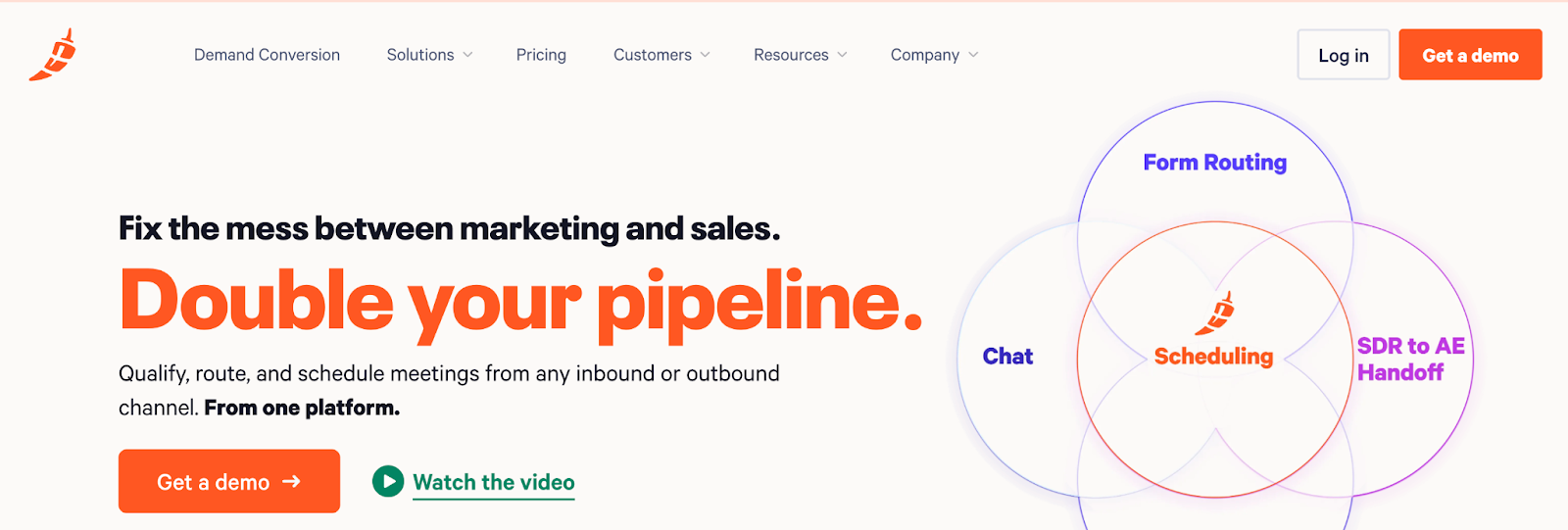
Chili Piper is a sales automation and meeting lifecycle platform that instantly qualifies, routes, and schedules leads the moment they engage. Rather than the slow, manual process, the sales team can connect directly with your lead form, qualify the lead in real-time, book meetings instantly, and route them to relevant sales reps based on the rules you set.
Like Calendly, Chili Piper stands out for its integration with third-party platforms, streamlining your workflow. Every meeting booked or routing decision made automatically syncs with your CRM, boosting productivity without disrupting your workflow.
Pros
- Increased meeting rates to increase the chances of conversion.
- A flexible routing system to connect leads with the right reps.
Cons
- Interfaces can require some setup and take time to become familiar with.
- Pricing may not be convenient for startups and other small businesses.
Pricing
Chili Piper’s pricing plans start at $45 per month.
G. Sales Reporting & Forecasting
13. Gong.io – Conversation intelligence tool with analytics and pipeline insights.
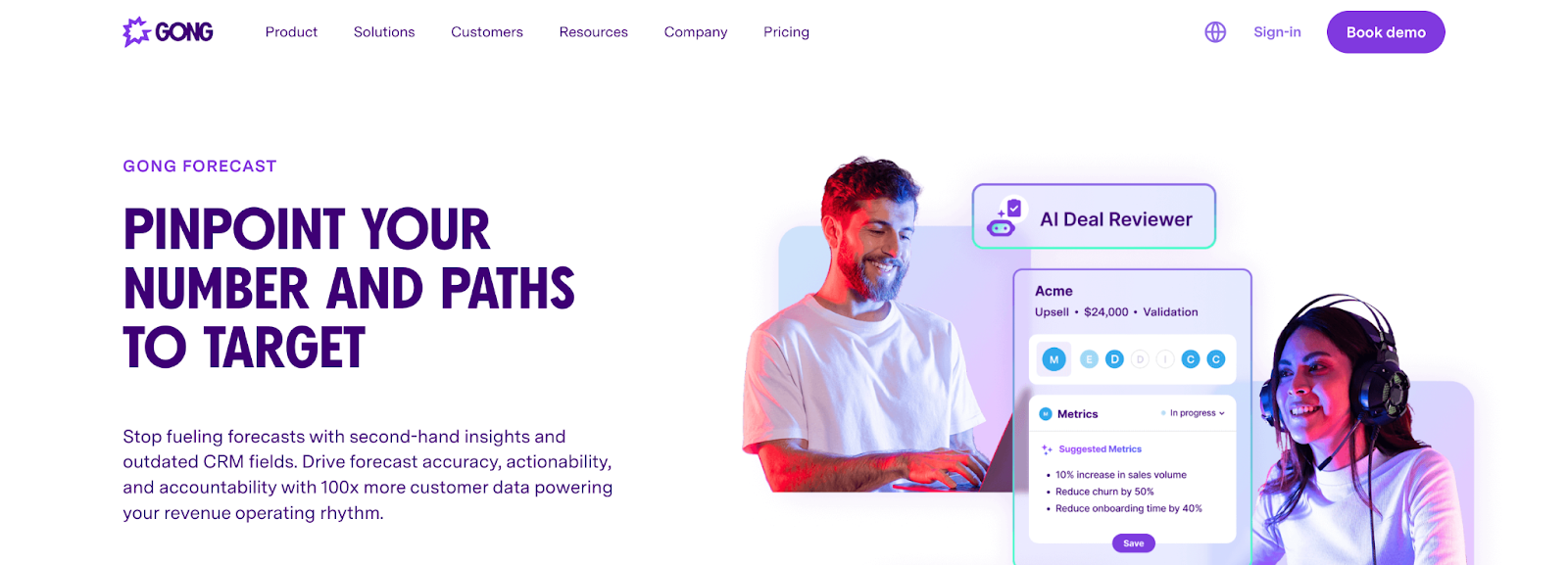
Gong is a revenue intelligence and sales automation platform that uses AI to analyze sales conversations and pipeline activity to help sales teams make informed decisions. You can generate actionable insights into your deal progress, determining who’s involved, how engaged they are, and identifying which ones are the real opportunities.
What gives Gong an edge over its competitors is its 300+ buying signals, which you can leverage to predict deal outcomes with high-level precision. You can diagnose and avoid forecast risks, move the pipeline forward, and manage your account all from one platform.
Pros
- Generate actionable insights into pipeline health and reps’ performance.
- Makes forecasting more accurate, helping teams make informed decisions.
Con
- It may be too expensive for smaller teams.
Pricing
Contact the sales team for a quote.
14. Clari – AI-driven forecasting and deal-tracking platform.
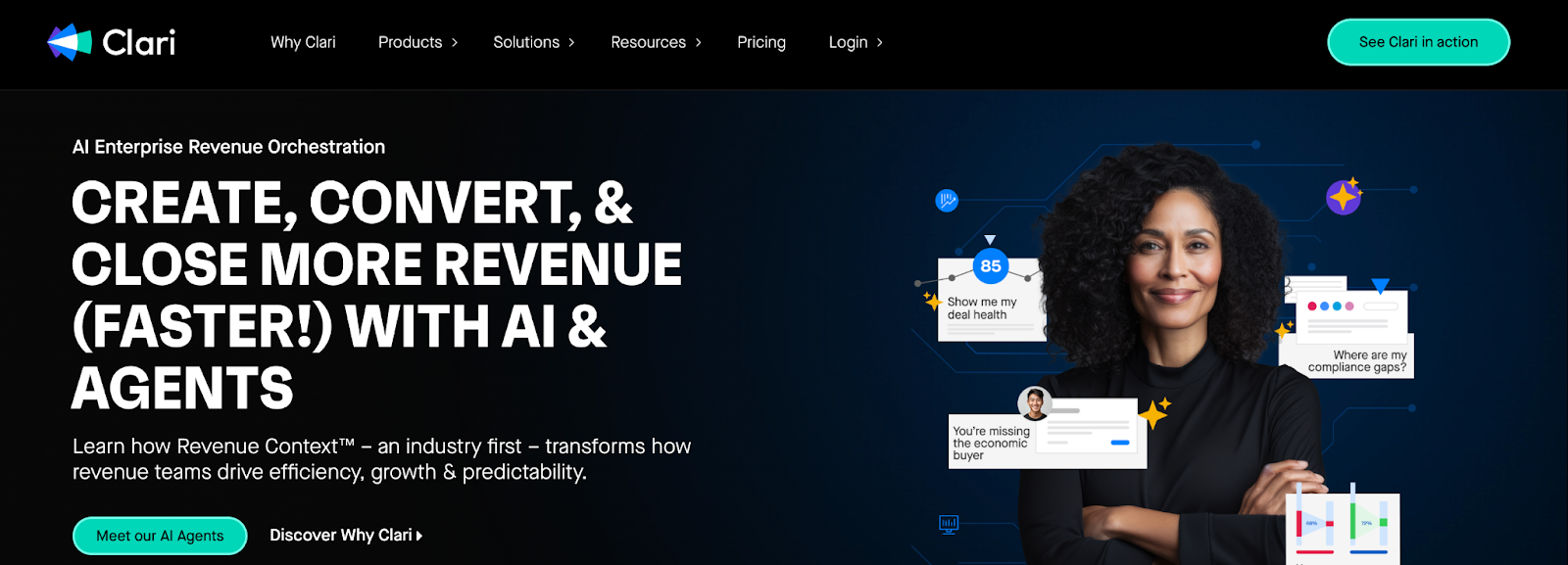
Our final option on the list is Clari. The revenue intelligence platform pulls data from different sources — CRM, emails, calls, calendars, and more — and leverages AI to generate actionable insights that can help sales teams make decisions.
Besides, it’s renowned for its AI-driven forecasts, which are based on real behavior, not guesswork. It provides live deal insights so you can flag risks early, monitor your sales activities, and stay ahead of competitors.
Pros
- Eliminates manual forecasting guesswork.
- Provides detailed information on the pipeline health.
Cons
- It’s designed for mid-sized and enterprise organizations, making it unsuitable for small teams.
- It’s more expensive when compared to other tools.
Pricing
Contact the sales team for a quote.
How to Evaluate Sales Automation Software
Choosing sales automation software can be a daunting task. However, here are some key factors you can leverage to select the right sales automation tool for your business.
1. Considerations by company size (solo, SMB, enterprise)
Every business is different. They’ve got different needs, processes, and resources. A simple, affordable solution that works for a small business may not be suitable for an enterprise. A larger enterprise may require a robust solution with more comprehensive features, enabling it to scale effectively.
For instance, a case study revealed that Inkwell, a content marketing agency, abandoned Salesforce for Pipedrive because it found the platform too complex and unsuitable for small businesses. That’s what happens when a tool doesn’t align with the business’s size. Hence, find a solution that’s suitable for your business, and scale as you grow.
2. Industry-specific needs (B2B vs. B2C)

Instead, find a tool that aligns with your industry-specific needs, especially if you’re a B2B or B2C company. A B2B sales automation tool should have features such as advanced sales prospecting and scoring, email outreach and multi-channel capabilities, or CRM integrations, supporting the lead nurturing process and catering to a longer sales cycle.
On the other hand, B2C sales automation software will have features such as behavior-based automation, live chat, conversion tracking, and integration with e-commerce platforms, which are best suited for emotional, impulse-driven purchases. Two tools, different features. Therefore, you must determine what truly works for you.
3. Integration with your existing tech stack
As mentioned earlier, sales automation software will disrupt your workflow. Consider the challenges of manually exporting data using spreadsheets, and even worse, losing track of leads. However, with integration, your data flows seamlessly. You can pull real-time data from CRM to personalize messages, sync lead activity, or auto-update opportunities as the deal progresses.
4. Budget and scalability concerns

Even with a user-friendly interface and demos, a tool that doesn’t align with your budget becomes a liability, not a solution, as everything ultimately falls back to your return on investment (ROI). So you can’t afford to choose a tool that’s way beyond your budget. Instead, look at the actual amount and the hidden fees.
Consider its implementation and onboarding process, training cost, and integration with the existing stack. These hidden costs let you determine the estimated amount you would spend when acquiring the tool.
5. User interface and ease of onboarding
If your tool takes one week to figure out and navigate, chances are it will get abandoned and collect digital dust. Your sales team doesn’t have that time. What they need, instead, is a clean, intuitive interface that’s easy to use and requires less time experimenting. The faster they can adopt the tool, the sooner they can achieve results.
Conclusion
There you have it. The 14 best sales automation tools that speed up your sales process and unlock growth opportunities for your business. If you find it challenging to maximize the full potential of these sales tools, consider partnering with ColdIQ to flood your sales pipeline with opportunities.
Combined with working strategies, our sales experts utilize these AI sales tools to revolutionize your sales process and generate real sales results. Book a demo with us today!
FAQ
Sales automation best improves repetitive tasks like data entry, lead scoring, and email follow-ups. Automating these activities lets salespeople focus more on personal contact and closing deals rather than routine paperwork. It increases efficiency without losing the human touch.
Automation tools centralize data and communication, making it easier for sales teams to access up-to-date information and track progress together. This shared visibility reduces silos and ensures that everyone works from the same detailed insights and customer interactions.
How does automation affect customer experience in sales?
What key factors determine ROI in sales automation investments?
Let's Get Started!
Schedule a 30-minute call with ColdIQ leadership to learn how our outbound strategy and sales tools help generate qualified leads and close deals.
.avif)
.svg)

